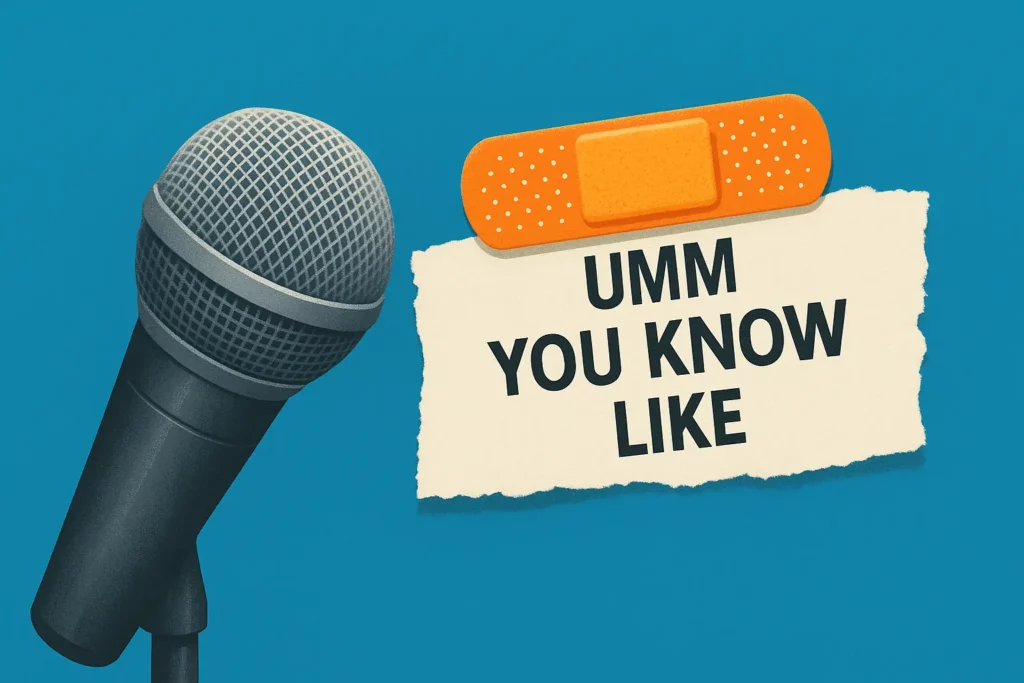How to Eliminate Verbal Crutches and Speak with Real Presence


Have you ever had to deliver bad news? Like telling a team member they’re not getting promoted, or worse, that their role is being made redundant, and found yourself saying “you know… I mean… like…” a few too many times?
You had the facts, the data, the empathy, but your words started to stumble. Those little fillers slipped in as your brain tried to comfort you.
They make you feel safer, but they quietly chip away at the executive presence you’ve worked so hard to build. They whisper uncertainty when you want to show conviction.
These are verbal crutches, or, more simply, fillers.
These are verbal crutches, my friends. Or as I like to call them, the tiny cracks in the wall of your authority. While most people will have a couple of them as natural parts of their speech, more than a few in the same breath, chip away your effectiveness as a speaker.
This isn’t about vocabulary; it’s about comfort. It’s about the nervous habit of filling every single sonic space, rather than owning the power of silence.
The Classroom Moment: Unmasking the Crutches
I remember an open program on Executive Presence, where I invited participants – brilliant CXOs, startup founders, seasoned product managers, to speak for just 30 seconds on a topic of their choice. Anything from their latest project to their morning cup of coffee.
The only rule? Every single “um,” “like,” or “you know” meant they had to pause, breathe, and start that sentence again.
At first, the room was a symphony of stifled giggles and awkward, restarting sentences. It felt a little silly, a little vulnerable. But then, a truly magical transformation began to unfold.
Voices slowed down. Thoughts became more deliberate. Words landed with a newfound precision. People weren’t just speaking; they were choosing their words.
They realised, right there in that moment, that these verbal crutches weren’t just innocent quirks. They were habits born of discomfort. And when you stop clinging to that false sense of comfort, you naturally start projecting genuine confidence. It’s a powerful shift.
The Second Round: From Crutch to Command
We then moved into a second, even more impactful round. I asked each participant to complete one short, punchy statement, like:
- “I’m leading this project because…”
- “Our biggest challenge right now is…”
- “What I want my team to know is…”
This time, the rule was simpler, yet profoundly challenging: Replace every filler with a pause. Not a rush, not another word, just… silence.
Those pauses, once awkward and uncomfortable, began to blossom into moments of power. The room filled with intentional stillness. The silence wasn’t empty; it was earned. It was a space for their words to land, to resonate.
People started to sound calmer, more grounded, utterly in control. In literally five minutes, they had transformed how they sounded, and perhaps more importantly, how they felt about their own voice.
That day, silence didn’t just become punctuation; it became presence. It transformed their communication from a frantic dash to a measured, confident stride. It’s like a beautifully composed piece of music where the rests are as important as the notes.
Why It Matters: Your Voice, Your Legacy
For C-suite executives and business strategists like you, your voice is more than just a means of conveying information. It’s the primary instrument of your influence, the very fabric of your executive presence. It’s how people gauge your conviction, your clarity, your leadership.
Think about it: when you’re leading change, articulating a bold vision, or negotiating a critical deal, every word, every nuance, every pause contributes to how you’re perceived. Do you sound decisive, or hesitant? Grounded, or unsure?
Your personal brand, that unique taste of your professional presence – like the comforting quality of a Naturals Ice-cream or the trusted design of an Apple device – is amplified or diminished by how you communicate. Fillers are like static on a clear radio channel. They disrupt the signal.
When you eliminate fillers, you’re not just sounding better; you’re being more present. You’re demonstrating emotional intelligence, a controlled composure even under pressure. You’re building credibility, one intentional pause at a time.
Hope you’ll forgive me for repeating this: this isn’t about perfection; it’s about intention. It’s about respecting your message enough to deliver it without verbal clutter.
How You Can Build This Powerful Habit

This isn’t an overnight fix; it’s a muscle you build with consistent, deliberate practice. Here are five practical steps to start making silence your superpower:
- Record Yourself Once a Week: This is probably the toughest, most humbling step, but also the most transformative. Play back a short segment of a meeting, a presentation, or even a voice note you sent. Actively count your fillers. Awareness is the first step to instant change. You’ll hear things you never noticed before, and that self-awareness creates a powerful impetus to improve.
- Replace Fillers with Breath: The next time your brain instinctively reaches for that “um” or “like,” don’t panic. Instead, take a slow, deliberate breath. This simple act does wonders. It grounds you, gives you a split second to gather your thoughts, and projects an aura of calm assurance. You’ll sound more assured, and crucially, you’ll *feel* calmer too. It’s EQ in action.
- Practice the 3-Second Pause: Between key ideas, or before delivering a significant point, intentionally hold silence for three full seconds. This isn’t just about avoiding fillers; it’s about creating gravitas. It gives your words space to land, to sink in with your audience. Think of a powerful Bollywood monologue – it’s the pauses, the timing, that amplify the impact, not just the rapid-fire dialogue. *Imagine* the impact of a leader who knows exactly when to let the silence speak volumes.
- Simplify What You Say: Often, fillers appear when we’re trying to articulate a complex idea with convoluted sentences. Long, cluttered thoughts invite verbal crutches. Instead, practice breaking down your message into shorter, clearer, more concise thoughts. Shorter sentences sound stronger, more direct, and leave less room for ambiguity – or fillers. Like the elegant, minimalist design of a well-loved app, clarity comes from stripping away the unnecessary.
- Ask for Feedback in a Safe Place: Find a trusted colleague or a mentor and ask them to specifically listen for your fillers during a short talk or a team meeting. It might feel a bit vulnerable, but it’s an incredible tool for accelerated learning. Consider it a “fail fast, learn faster” approach to your communication style. Their objective perspective will highlight patterns you might miss, and empower you to refine your approach.
Final Thoughts: Own Your Voice, Own Your Impact
In leadership, your voice carries your presence, your personal brand, your entire vision. It’s how people decide if they can truly trust you – not just what you say, but how you say it, with what conviction, and with what clarity.
Executive presence isn’t about having the perfect, flowery words. It’s about speaking with intention, with calm, and with unwavering confidence. It’s about being heard for the substance of your message, not the distractions that dilute it.
Look at the founders of Zerodha Broking Ltd – they built a brand not just on an online trading platform , but on clear communication of their disruptive vision. Their story is powerful because it’s told with conviction, without unnecessary noise.
Take a breath. Feel that tug – that call to own your professional story, to make your voice truly resonate? Because that’s what this is. It’s not about being perceived as “tougher” or “nicer.” It’s about being seen as authentic, credible, and consistently clear. It’s about being trusted.
Challenge for the Week
Ask yourself:
- What is one area of my communication where I know fillers tend to creep in? (e.g., when giving bad news, answering a tough question, or presenting a new idea).
- How can I consciously replace those fillers with a strategic pause or a clarifying breath in my very next high-stakes conversation?
Remember, your personal brand is not static — it’s a living system that evolves as you do. If this article sparked something in you — that “Yes, I can change this” moment — that’s where transformation starts.
In this attention economy, silence won’t get you noticed, but authentic, assertive clarity will make your voice unforgettable.
So, speak up.
Share your vision.
Make it bold. Make it clear. Make it you.
Until next time — keep learning, keep reflecting, and most importantly, keep showing up.
Because how you show up shapes how far your impact travels. Now go own that assertive voice — and let it do the talking.
P.S.: The best leaders, like the best stories, know exactly when to pause for dramatic effect. When will you own your pause?
This article is written by Suman Addepalli, Director & Executive Presence Expert, GlobalGyan Leadership Academy and 6x Published Author






Responses